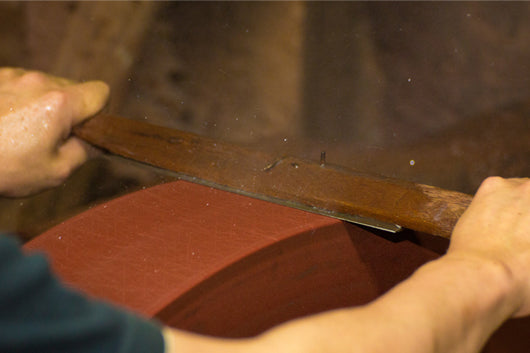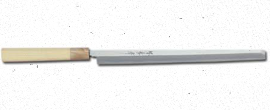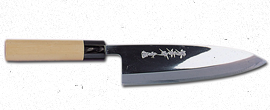Japanese Knives

History of Japanese Sakai Knife Making

The city of Sakai is situated by the Osaka bay at the Japanese main island. It is said that the foundations for knife making were laid down as early as the fifth century AD , when the great mounds, the kofun, were built. This required excellent tools, which were manufactured by local craftsmen.
During the 14th century Sakai became the capital of the samurai sword making. The city kept its position during the centuries to come, and in the late 16th century they started making knives according to the same methods as the famous sakai swords.
The making of knives was a result of the Portuguese introduction of tobacco in Japan. The demand for quality knives to cut the tobacco exploded. The first tobacco knives were made in Sakai, and they were soon renowned all over the country for their unique sharpness.
The so called Meiji Restoration took place in the late 1860’s. The shogunate lost its powers, the empire was reintroduced and efforts were made to modernize Japan.
The samurai class lost some of its privileges and was no longer allowed to carry swords. Even though the army still needed swords, the demand sank and many of the manufacturers started making knives instead.
Traditional Japanese Sakai Knife Making

Traditional Japanese knife making includes several steps which all require great skills. The smith forging (hizukuri), when the metal is heated an hammered to its shape, the sharpening and honing (hazuke or togi), when the blade gets it sharp edge and finally the hafting (ezuke), when the blade is attached to a haft, or a handle, of magnolia wood. Today’s processes uses the same technique as the masters of old did. Sakai cutlery consists of layers of soft ferrite and hard steel, heated to 1300 ° C and hammered together. The most difficult aspect of the process is maintaining the heart at the exact temperature; too hot and the blade will chip easily, too cool and the steel and the ferrite will fail to bond properly.

The blade is heated, hammered and cooled in different steps and at different temperatures. Asymmetries are not accepted and the blade is meticulously treated with hammers of different size to make it no less than perfect. It takes long practice and great skill to make an excellent blade.
The blade is then sharpened and any remaining asymmetries removed by using increasingly finer whetstones, giving the edge its right angle and sharpness. The last step is to carefully hammer the blade into a haft of rot-resistant magnolia wood, marked with the manufacturers seal. A high quality piece of Japanese culture and skills is ready for shipping.
Japanese Style Knife

Japanese style knives have a beveled edge on just one side, the other side of the blade remains flat. Japanese style knives often maintain their sharp edge much longer than Western style knives.
Western Style Knife

Western style knife the cutting edge is typically beveled on both sides. Western style knives are more practical on tough foods, like beef, especially to get them down to manageable size.
The difference between Japanese Knives and Western Knives
Japanese Knives and Western Knives may appear similar at first glance, but to a professional they have one small change which make a large difference in how they prepare food. Japanese knives have a beveled edge on just one side, the other side of the blade remains flat.
On a Western knife the cutting edge is typically beveled on both sides. Japanese knives are designed in such a way that perfect 90 degree angles for sashimi are achievable, with any Western design knife the resulting sashimi would have a scalloped edge.
The only downside to this design is that Japanese knives are specifically left or right handed, while a Western knife can be used with either hand. The Kataba is used for filleting whole fish and for achieving straight flat cuts.
Western knives leave rough edges, which hinder the absorption of flavors during cooking. Western knives are more practical on tough foods, like beef, especially to get them down to manageable size. The final cuts however are often best made with a Kataba which allows for speed and control.
Western knives are made with a softer steel than Japanese counterparts. This results in Western knives being much thicker. Western knives are often sharpened to a 20 degree angle on both sides, resulting in a 40 degree profile. A Usuba, is cut to a 10 degree angle on one side and flat on the other, making the total profile a mere 10 degrees. If you were to sharpen a Western knife in a similar ,10 degree profile, manner it would crumble like a piece of tin foil as soon as you cut anything with it. A Usuba can be chipped easily, but the whole knife is much stronger than a comparable Western knife.
Japanese knives often maintain their sharp edge much longer than Western knives. This is due mainly to how they are used Western knives are banged down, while Japanese knives are dragged across, this results in the blade being protected from force which damages it more quickly. Honyaki-Bocho knives are created from a solid piece of raw steal that is forged and tempered. The blade of a Honyaki-Bocho is easier to sharpen, but the Kasumi-Bocho is considered superior by many chefs. Kasumi-Bocho take longer to make as well as sharpen. They require more work to sharpen and maintain, but maintain their cutting edge much longer and have a longer life in general than the easier to sharpen Honyaki-Bocho.
Styles of Western Knives
Gyutou

The gyutou is a versatile chef's knife. It can be used for cutting meat, fish and vegetables, making it suitable for preparing Western cuisine.
Slicer

The Slicer is a slicing knife intended for slicing boneless fish filets. It can also be used for slicing boneless roasts, hams and poultry breasts.
Petty

The petty is a smaller chef knife that makes it a convenient size for peeling and other delicate work.
Styles of Traditinal Japanese Knives
Yanagi

The yanagi used to slice boneless fish fillets into sashimi and toppings for sushi. The graceful, thin blade cuts beautiful slices in one long, drawing stroke.
Takohiki

The takohiki is a variation of the yanagi and is used to slice straight-cut sashimi. It’s thin body makes cutting thin slices of fish easier than the yanagi.
Fuguhiki

The Fuguhiki is a traditional Japanese style fish slicer, similar to the yanagi. ‘Fugu’ or blowfish is traditionally served on a painted plate, and cut extremely thin.
Usuba

The Usuba is a traditional Japanese knife used to cut or make thin sheets of vegetables. Originated in Kanto (Tokyo) region of Japan.
Kamagata Usuba

The Kamagata Usuba is a traditional Japanese knife used to cut or make thin sheets of vegetables. The kamagata usuba has a pointed tip, which allows for more delicate work.
Knife Materials
Blue Steel [Aoko]
Blue Steel is the highest quality steel material produced by our supplier Hitachi Metals. The characteristics of this steel are its high edge retention and durability. Knives made from this material are commonly used in restaurants such as Sushi Restaurants, where there is a need to continuously slice Sashimi, since the steel retains its edge the chefs are able to produce beautifully prepared Sashimi all day long.
White Steel [Shiroko]
White Steel is the next highest steel material after Blue Steel and has good edge retention, and is easy to sharpen. At Jikko White Steel is our number 1 recommendation to chefs. For those uncertain which steel type is best, we think you should buy white steel as you should not have any problems.
Japanese Steel [Nihonko]
Japanese Steel has been used standard steel type to produce knives in Japan since long ago. We highly recommend this type to first time knife buyers or to those who have not purchased steel knives before. Prices are also quite reasonable.
Silver 3 Steel [Ginsanko]
This is a high grade stainless steel. The image of most rust resistant knives is that they have a poor edge compare to knives which are susceptible to rust, however, the characteristic of this metal is that is rust resistant and also has a good edge. This is currently the most popular steel type.
Damascus Alloy Steel
The strongest point of this steel is its own pattern produced during solidificfation of cast steel in a crucible firnace and is said that only a few of people know about this manufacturing knowhow. In the days of the crusade the sword was noted for its mysterious beauty and preciousness. The present Damascus design has been realized on the pattern of this Damascus steel.
Uddeholm Swedish Steel
The Uddeholm company manufactures the steel used in the Grand Chef Knife series. Established in 1670 in the Munkfors district, Sweden, Uddeholm has a history of more than 1300 years. In the field of precision rolled steel products, the company leads the world. Since quality iron ore excavated from company mines contains an extremely low amount of phosphorus and sulfur, the special steel is reputed to be of the finest in the world. The Grand Chef Knife series products use the special Swedish steel manufactured by Uddeholm and offer exceptional sharpness and abrasion and corrosion resistance for many years of service.
Molybdenum Steel
This is the most commonly used steal for rust resistant knives. Since this metal is highly rust resistant we suggest this type to those who do not like their knives rusting.
Our Knife Brands

Sakai Takayuki
Sakai Takayuki Knives has been cultivated through a long 600-year history. Well known throughout the nation, Sakai knives are created by the assured skills of craftsmen and boast top-class, clean cutting In 1982, the knives were designated traditional arts and crafts. While the number of craftsmen with excellent skills decreases each year, the superb workmanship and technology that create the knives maintain an excellent reputation.
Inheriting the long-established technologies of Sakai knives, Aoki Hamono Seisakusho Co., Ltd., started its business with the enthusiastic intent of manufacturing exceptional knives by adding more advanced technologies. Ever since our founding, we have achieved many unique technical developments and, through trial and error, continued to develop new products. We will spare no effort in creating knives that are beloved by people. We are proud of the long-established tradition of Sakai knives.

Sakai Takayuki Craftsman
Meister Mr. Keijiro Doi (Blacksmith)
 He was born in 1927 and entered the field at the age of 19 succeeding his father who was reputed to be a master in Sakai. After many years of training. He was certified a Blacksmith Meister in 1987 by the Minister of International Trade and Industry. Furthermore, in the 1997 Spring Conferment, he was awarded the Green Paulownia Leaves Medal.
He was born in 1927 and entered the field at the age of 19 succeeding his father who was reputed to be a master in Sakai. After many years of training. He was certified a Blacksmith Meister in 1987 by the Minister of International Trade and Industry. Furthermore, in the 1997 Spring Conferment, he was awarded the Green Paulownia Leaves Medal.
Meister Mr. Yukinori Oda (Sharpener)
 The Order of the Sacred Treasure, Silver Rays, in 2007. He has been involved in grinding knives for 53 years. At the age of 20, he was apprenticed to a master. “Sharpness of a knife is 100% even for a brand-new one. Enhancing it to 120% is the job of knife grinders.” He still engraves the lesson implanted by the master in his mind. “Even if a knife is worn out, sharpness comes back when it is re-sharpened.” Oda is pursuing the manufacture of genuine knives.
The Order of the Sacred Treasure, Silver Rays, in 2007. He has been involved in grinding knives for 53 years. At the age of 20, he was apprenticed to a master. “Sharpness of a knife is 100% even for a brand-new one. Enhancing it to 120% is the job of knife grinders.” He still engraves the lesson implanted by the master in his mind. “Even if a knife is worn out, sharpness comes back when it is re-sharpened.” Oda is pursuing the manufacture of genuine knives.
Custom Knife Craftsman Mr. Keido Sugihara
 As a customized knife craftsman, he has many fans. The unique knives he creates are worth calling artifacts. He mainly designs handles made of desert iron wood.
As a customized knife craftsman, he has many fans. The unique knives he creates are worth calling artifacts. He mainly designs handles made of desert iron wood.

Sakai Kikumori
Sakai Kikumori is proud to introduce their line of professional Japanese chef knives to the North American culinary culture. Those who cook for a living, or as a way of life, often take pride in having the best kitchen knives. That is why Sakai Kikumori takes pride in forging the very best in professional kitchen knives. What makes Kikumori knives outstanding are the qualities that result from a centuries old practice of craftsmanship. Traditionally made Japanese kitchen knives inherit techniques employed in making katana, the swords of the samurai, that were not only weapons upon which warriors' lives depended; they were symbols of honor and devotion to discipline.
For over 87 years Sakai Kikumori has produced several lines of professional chef knives. Located in the historic knife forging city of Sakai City near Osaka, Japan, all knives carrying the Sakai Kikumori brand have gone through a rigorous production process from forging to polishing. Sakai Kikumori knives are renown for their design, functionality and great edge retention.
Sakai Kikumori - Chouyou

The Chrysanthemum is called KIKU flower in Japanese.
They named their brand Sakai Kikumori from “Kiku”.
In Japan, people pray for a long life to Kiku on 9 September. The day is called “Chouyou”.

Brilliant Masterpiece
A trusted brand, “Sakai Kikumori” presents a new series of the highest quality – uniting the most pleasant in use and beauty. It is reflected the voice of the professional chefs and pursed the simplicity of use. Chouyou, a masterpiece that the top craftsmen diligently product from forging, the very first process in handmade forged knife, to the final process of shrpeing.
The handle is made from HO (the Japanese Magnolia) wood which has a smooth feel and hold up in heavy use. It is finished in a little slim octagonal shape which enables to fit comfortably in your hands but not slippery.
Sakai forging knife is made to draw the original characteristics of steel to the maximum by the craftsman. Chouyou is produced by the master craftsmen in Sakai from forging to sharpening and create the astonishing cutting performance.
The work of the top craftsmen also allows “easy care”. The perfect distortion-free blade gives sticking-like sharpening on the whetstone. Just a little sharpening brings back the sharpness.
The package is designed to express the Chouyou’s attractive beauty and functionality. It is offered to you in a special made white box of Japanese paper. It is also suitable for a gift.


